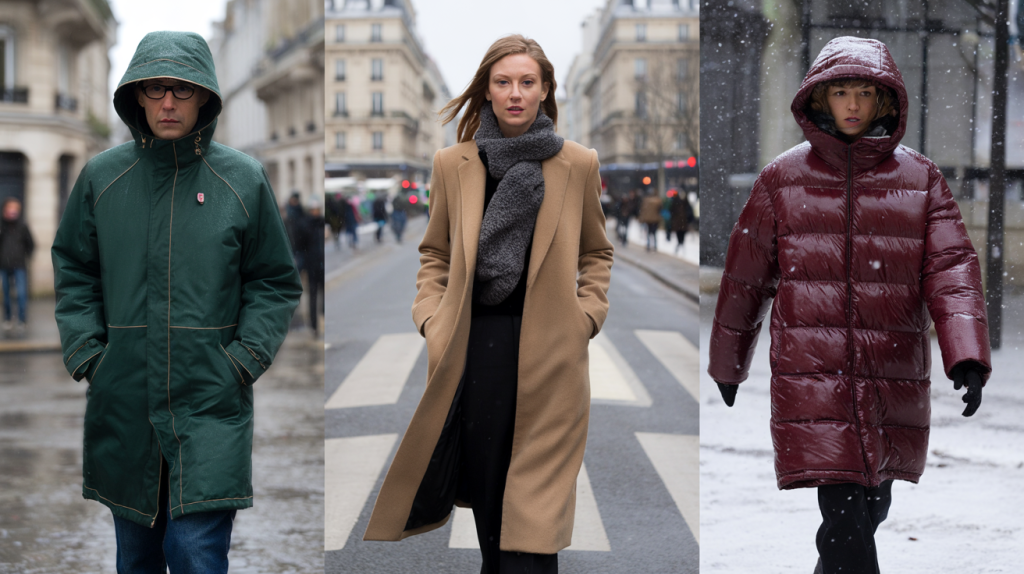Cold, rain or snow on the way. Find the winter coat that truly matches your weather, commute and style without guesswork.
Scrolling endless puffers and wool coats can feel like roulette. The fast answer lands here : pick by climate first, then by lifestyle. Mild and dry days call for a long wool coat. Wet and windy cities need a waterproof parka rated at least 10,000 mm. Deep cold rewards a 700 fill power down puffer. In changeable weather, a trench with a removable liner earns its place.
From warmth ratings to fabric science, the right choice is not about trends alone. Length controls draft, insulation traps heat, and a good hood saves commutes. Add one detail that changes everything : movement. Shoulders, armholes and vents decide if a coat works in real life or stays on the hanger.
Winter Coat Essentials : Wool, Down, Parka or Trench
Observation first : most winter days fall into three buckets. Cold and dry, cold and wet, or damp and mild. That is why four archetypes keep coming back. A long wool coat for polish and breathable warmth. A down puffer for light weight heat on the coldest mornings. A waterproof parka for sleet and coastal wind. A trench with liner for on and off seasons.
Problem solved when fabric meets function. Wool insulates while letting moisture escape, so commutes and office days feel balanced. Down delivers maximum warmth per gram, great when temperatures dive. Parkas add storm flaps, taped seams and lined hoods to block wet chill. Trench coats with button in liners stretch across months without swapping wardrobes.
Warmth by the numbers : insulation, fill power and waterproof ratings
Numbers cut the noise. The clo unit expresses insulation. One clo equals the insulation of a typical business suit as defined by ISO 9920 : 2007. Layering a knit under a wool coat plus a scarf can raise total insulation by about one clo, felt immediately on wind exposed streets.
Down warmth is about fill power. Look for 700 to 900 fill power for light yet toasty puffers. Higher fill power traps more air per ounce, which is why the jacket stays warm without bulk. Reference : REI Co op Expert Advice explains fill power ranges and their real warmth on trail and in town.
Wet winter ahead. Waterproof ratings tell you how long a fabric resists rain. A parka rated 10,000 to 20,000 mm suits steady rain or wet snow, while below 5,000 mm is for light showers only. Source : REI Co op Waterproof Ratings Guide. Seam sealing and a visor style hood matter as much as the number.
Material science helps on clammy commutes. The Woolmark Company notes that wool can absorb up to 30 percent of its dry weight in moisture while still feeling dry, which keeps microclimate comfort steady when moving from subway to street. For breathability tests on textiles, ISO 11092 : 2014 covers thermal and evaporative resistance, a reminder that comfort is more than warmth alone.
Common mistakes : fit, length and fabric that fight your lifestyle
Too tight at the shoulders is the classic error. Coats with high armholes and a little back pleat let knits and blazers slide underneath. If the front pulls when you hug yourself, size or cut is off and heat will leak at the buttons.
Length matters more than many think. Mid calf cuts seal out drafts at bus stops and bike lights, while thigh length works better for driving and quick strides. Sit, walk, climb stairs in the store. Small test, huge payoff.
Choosing puffer loft without thinking about wind or rain creates regret. Feather light puffers feel amazing but lose warmth when soaked. In wet regions, a water resistant shell or a separate rain layer over the puffer changes the game. On dry cold days, skip membranes and enjoy breathability.
Ignoring care is another trap. Down needs a tumble with clean tennis balls to restore loft. Wool prefers occasional brushing and steaming. Simple, low effort routines keep insulation alive for years, which saves money and cuts waste.
Quick picks by scenario : choose the coat that matches your winter
Different days, different needs. Use this fast map to land on the right piece and move on.
- City office with mixed weather : Long wool coat, mid calf, stand or notch collar, double faced wool for drape and warmth. Add a scarf to bump insulation by roughly one clo.
- Snow and sub freezing commutes : 700 to 850 fill power down puffer with box or baffle construction, insulated hood, cuff gaiters. Look for Responsible Down Standard on the label.
- Windy coastal rain : Waterproof parka rated 10,000 mm or higher, full seam sealing, two way zipper, lined hood with brim. Hand warmer pockets help more than you think.
- Mild, changeable climates : Cotton gabardine trench with removable insulated liner, storm collar, back vent. Belt ties stop drafts on brisk mornings.
- Weekend walking and errands : Fleece lined chore coat or insulated shacket for easy layers, zipped inner pocket for phone, machine washable shell.
Color and texture seal the deal. Camel and charcoal anchor wardrobes, but a deep forest green or oxblood wakes up winter outfits. Matte shells look quieter, glossy puffers bounce light on grey days. The goal is not just heat. It is a coat that does not weight you down and still sparks a little joy at 7 a.m.
Two last moves turn choice into confidence. Check the hood field of vision and the collar height during a windy corner test. Then read three labels in order : insulation type and fill power, waterproof rating if relevant, and care. When those align with your climate and routine, the right winter coat is already in hand.
Sources : ISO 9920 : 2007, ISO 11092 : 2014, REI Co op Expert Advice on Fill Power and Waterproof Ratings, The Woolmark Company on moisture management.
